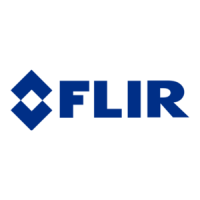
Do you have a question about the FLIR SC2500 and is the answer not in the manual?
| Resolution | 320 x 240 pixels |
|---|---|
| Operating Temperature | -15°C to +50°C |
| Storage Temperature | -40°C to +70°C |
| Temperature Range | -20°C to +350°C (optional up to +1500°C) |
| Field of View | 24° x 18° |
| Frame Rate | 60 Hz |
| Display | Built-in LCD |
| Video Output | NTSC/PAL |
| Power Supply | AC adapter or battery |
Instructions to stop operation immediately and contact FLIR Systems in case of equipment dysfunction.
Warning against disassembling the camera; internal parts are dangerous and require a qualified technician.
Prohibits using the equipment in flammable gas environments due to explosion or fire risk.
Emphasizes using only dedicated cables supplied by FLIR Systems for camera compatibility.
Device will be damaged if immerged in water or exposed to high temperatures.
Equipment may malfunction if subjected to extreme environmental conditions.
Handle objective and connectors gently, as these parts are particularly fragile.
Abrupt temperature changes can cause condensation inside the device.
Camera may malfunction after violent shocks or strong vibrations.
Describes the SC2500 camera, its InGaAs/VisGaAs detector, and key features for R&D and automation.
Lists items included with the camera, such as the camera body, power supply, cables, and software.
Details the physical components and connectors of the SC2500 camera through diagrams.
Ensure the camera is posed on a stable surface or correctly screwed on the tripod.
Instructions for installing necessary software, drivers, and acquisition software.
Connect power, Ethernet, and optional video cables to the camera and computer.
Turn the camera on by pressing the ON/OFF button and wait for the system to display a pattern.
Ensure the object is at the center of the image and that focusing is optimized.
Turn the camera off by pressing the ON/OFF button.
Specific precautions for environmental conditions, handling, and cable connection.
FLIR Systems offers training schemes to use the equipment to its full potential.
Instructions for safely removing and attaching lenses to the C-Mount interface.
How to remove the lens interface to install a custom interface.
Instructions for changing the filter holder, emphasizing care with fragile elements.
Steps to remove and replace IR filters in the filter holder.
How to connect the Lock-In option using an X0914 cable to the SC2500.
Details special features like Gain modes, Integration modes, and TEC Module.
Provides basic steps for performing a Non-Uniformity Correction (NUC) using software.
Describes how to calibrate the camera for temperature measurement using specific filters and settings.
Instructions for cleaning optical elements, including dust and surface mark removal.
Guidelines for putting caps on lenses and storing the camera in a dry, cool place.
Information about the range of additional lenses available for the SC2500 camera.
Mentions FLIR's selection of tripods and motorized turrets for various uses.
Describes infrared filters for spectral selection and attenuation of radiometric flux.
A table troubleshooting common problems and their solutions for the camera.
Provides contact information and website for FLIR Systems after-sales service.
Details the technical specifications and characteristics of the SC2500 camera.
Compares the spectral quantum efficiency of InGaAs (SC2500N) vs VisGaAs (SC2500VN) detectors.
Provides detailed drawings and dimensions of the camera's mechanical interfaces.
Details the pinout and specifications for the power supply connector.
Details the pinout and specifications for the VIDEO connector.
Details the pinout and specifications for the Trigger connector.
Details the pinout and specifications for the Lockin connector.